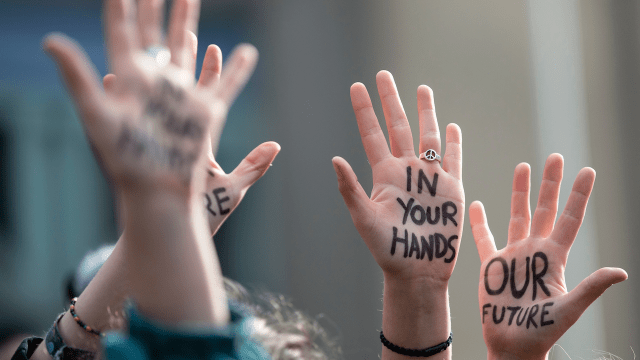Former Prime Minister Paul Keating famously said, “If you change the government, you change the country”, and that’s exactly what Australia was hoping for when we went to the polls this weekend. Australia’s election result speaks for itself.
It wasn’t necessarily that there was hatred for now-former Prime Minister Scott Morrison, although there was a lot of that, it was that Australia clearly cares about climate change more than the Coalition thought we did.
As Gizmodo Australia readers, I know you’re all thinking, ‘duh’. But inaction over climate change following devastating fires and unprecedented floods wasn’t going to fly this time.
This weekend will go down in Australian history of one of the most bonkers elections yet. As the ABC’s election guru Anthony Green wrote: “With a sea of teal independents winning seats on climate change and anti-corruption platforms and a swing towards the Greens in some capital cities, it seems clear that Australia’s appetite for the two major parties has diminished”. While the convenor of Climate 200, Simon Holmes à Court, said the results showed a significant proportion of Australians were “sick of nine years of failure” on climate policy.
When giving his victory speech on Saturday night, Prime Minister Elect Anthony Albanese reminded everyone climate action was a priority.
“The opportunity to shape change, rather than be shaped by it. And we can shape change more effectively if we seek to unite people on that journey of change,” he said.
“Together, we can end the climate wars.
“Together, we can take advantage of the opportunity for Australia to be a renewable energy superpower.”
Here’s the full speech, if you’re yet to watch it:
During his Budget reply speech Albanese declared: “Climate change is here and its consequences are devastating”. Obviously being two days in, we don’t have anything short of pre-election promises to go off, but here’s a summary of what the Labor party promised heading into the election:
- Powering Australia plan – under Labor’s plan, more than 200 of the nation’s heaviest polluters will be required to collectively lower their emissions over the next three decades to help achieve an economy-wide cut of 43 per cent by 2030, and net zero emissions by 2050. Analysis shows Labor’s proposed target, while far more ambitious than the previous government’s, is consistent with 2℃ of global warming. This is not yet in line with the Paris Agreement goal for “well below” 2℃ warming. Incumbent Warringah independent Zali Steggall is calling for at least 60 per cent emissions reduction by 2030, and the Greens want even more.
- Modernising the grid – this is an older commitment, made well before the 2022 Federal Election was on the cards. “Australia should be a renewable energy superpower, but our electricity transmission system is desperately outdated”, Albanese said previously. Labor’s Rewiring the Nation initiative will invest $20 billion to rebuild and modernise the grid.
- National Reconstruction Fund – Labor’s policies on industry emissions comprise: $3 billion to aid industry’s low-carbon transition, including for manufacturing of green metals such as steel and aluminium and a revised “safeguard mechanism” requiring big polluters to reduce emissions.
- EVs and some charging stations – dubbed “Driving the Nation”, Labor’s pitch is to create a $500 million investment in a national EV charging network. The ALP also pledged 130 new, locally manufactured electric buses for Western Australia. It will be a combined investment (a federal Labor government and state government spend) of $250 million.
- Battery manufacturing – the ‘focus on the climate’ also expands into climate-adjacent areas, with Labor also previously announcing a battery manufacturing policy. Batteries are central to a shift to renewables. They give renewables like solar and wind the ability to store energy that can later on be used to power energy grids. They’re also essential in EVs.
- Housing Australia Future Fund – Labor’s Housing Australia Future Fund is focused on building new social and affordable housing, but is silent on net-zero. All governments have agreed to a zero-carbon buildings trajectory – now it’s time the federal government worked proactively with the states to achieve this.
It wasn’t all Labor, however. The Australian Greens and the Teal Independents also focused on the climate. The Greens’ pre-election commitments included:
- Plan to phase out coal, oil and gas – “We are in a climate emergency,” the Greens state. They declare that without a plan to phase out coal and gas, there is no plan for the climate crisis. The plan for this plan is to make big corporations and billionaires “pay their fair share of tax to clean up the mess they’re making”, fund the transition to 100 per cent renewables and kick off a full-scale renewable export industry.
- Environment and animals – the Greens already had new environmental laws to stop corporations trashing the environment as part of its election plan, but they took it one step further, promising to appoint an Independent Environment Protection Watchdog to make sure no more animals go extinct. Zero extinctions by 2030, in fact. The Greens’ $24 billion environmental plan also calls for 2 billion trees to be planted by 2030 and for bushfire-ravaged forests and bushlands to be restored. According to the ABC, the Greens will fund this by “taxing billionaires and big corporations”
Albanese is now off to the Quad Leaders’ Summit in Tokyo to discuss climate change, but also a handful of other issues of significant importance to Quad members. If you’re not familiar, the Quad Leaders’ Summit brings together four leaders from Australia, Japan, India and the United States.
Anyway. It’s a nice change from a leader not taking climate change seriously, but we will be watching if these words translate into action and if the Teals/Greens will be listened to by Australia’s 31st prime minister. And so will the experts.
Everything’s coming up Milhouse.
